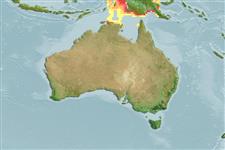Environment: milieu / climate zone / djupintervall / distribution range
Ekologi
marina; brackvatten pelagic-neritic; djupintervall 0 - 50 m (Ref. 189). Tropical; 5°S - 13°S, 132°E - 148°E (Ref. 189)
Western Central Pacific: Papua New Guinea (Fly River) and northern Australia (near Darwin).
Size / Vikt / Age
Könsmognad: Lm ? range ? - ? cm
Max length : 7.5 cm SL hane/ej könsbestämd; (Ref. 189)
Taggstrålar i ryggfenan (totalt) : 0; Taggstrålar i analfenan: 0; Mjukstrålar i analfenan: 32 - 29. Belly with 14 to 16 + 9 = 23 to 25 keeled scutes from isthmus to anus. Maxilla short, reaching to hind border of pre-operculum; first supra-maxilla short, about half length of second. Pseudobranch long. A diffuse dark saddle on nape; no dark blotch behind gill opening.
Body shape (shape guide): elongated; Cross section: compressed.
Presumed marine, pelagic and coastal, but at least the juveniles enter mangrove creeks of rivers, thus tolerating lowered salinities. More data needed.
Life cycle and mating behavior
Könsmognad | Reproduktion | Lek | Ägg | Fecundity | Larver
Wongratana, T., T.A. Munroe and M. Nizinski, 1999. Order Clupeiformes. Engraulidae. Anchovies. p. 1698-1753. In K.E. Carpenter and V.H. Niem (eds.) FAO species identification guide for fishery purposes. The living marine resources of the WCP. Vol. 3. Batoid fishes, chimaeras and bony fishes part 1 (Elopidae to Linophrynidae). FAO, Rome. (Ref. 9822)
IUCN Red List Status (Ref. 130435: Version 2025-1)
Threat to humans
Harmless
Human uses
Verktyg
Special reports
Download XML
Internet-källor
Estimates based on models
Preferred temperature (Ref.
123201): 27.4 - 28.3, mean 27.9 °C (based on 84 cells).
Phylogenetic diversity index (Ref.
82804): PD
50 = 0.5000 [Uniqueness, from 0.5 = low to 2.0 = high].
Bayesian length-weight: a=0.00427 (0.00181 - 0.01006), b=3.11 (2.93 - 3.29), in cm total length, based on LWR estimates for this Genus-body shape (Ref.
93245).
Trofisk nivå (Ref.
69278): 3.3 ±0.4 se; based on size and trophs of closest relatives
Resiliens (Ref.
120179): Hög, lägsta populationsfördubblingstid mindre än 15 månader (Preliminary K or Fecundity.).
Fishing Vulnerability (Ref.
59153): Low vulnerability (10 of 100).
🛈
